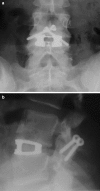A prospective, randomised controlled trial of femoral ring allograft versus a titanium cage in circumferential lumbar spinal fusion with minimum 2-year clinical results
- PMID: 16163514
- PMCID: PMC3489262
- DOI: 10.1007/s00586-005-1034-z
A prospective, randomised controlled trial of femoral ring allograft versus a titanium cage in circumferential lumbar spinal fusion with minimum 2-year clinical results
Abstract
The literature reports on the safety and efficacy of titanium cages (TCs) with additional posterior fixation for anterior lumbar interbody fusion. However, these papers are limited to prospective cohort studies. The introduction of TCs for spinal fusion has resulted in increased costs, without evidence of superiority over the established practice. There are currently no prospective controlled trials comparing TCs to femoral ring allografts (FRAs) for circumferential fusion in the literature. In this prospective, randomised controlled trial, our objective was to compare the clinical outcome following the use of FRA (current practice) to the use of TC in circumferential lumbar spinal fusion. Full ethical committee approval and institutional research and development departmental approval were obtained. Power calculations estimated a total of 80 patients (40 in each arm) would be required to detect clinically relevant differences in functional outcome. Eighty-three patients were recruited for the study fulfilling strict entry requirements (>6 months chronic discogenic low back pain, failure of conservative treatment, one- or two-level discographically proven discogenic low back pain). The patients completed the Oswestry Disability Index (ODI), Visual Analogue Score (VAS) for back and leg pain and the Short-Form 36 (SF-36) preoperatively and also postoperatively at 6, 12 and 24 months, respectively. The results were available for all the 83 patients with a mean follow-up of 28 months (range 24-75 months). Five patients were excluded on the basis of technical infringements (unable to insert TC in four patients and FRA in one patient due to the narrowing of the disc space). From the remaining 78 patients randomised, 37 received the FRA and 41 received the TC. Posterior stabilisation was achieved with translaminar or pedicle screws. Baseline demographic data (age, sex, smoking history, number of operated levels and preoperative outcome measures) showed no statistical difference between groups (p<0.05) other than for the vitality domain of the SF-36. For patients who received the FRA, mean VAS (back pain) improved by 2.0 points (p<0.01), mean ODI improved by 15 points (p=<0.01) and mean SF-36 scores improved by >11 points in all domains (p<0.03) except that of general health and emotional role. For patients who received the TC, mean VAS improved by 1.1 points (p=0.004), mean ODI improved by 6 points (p=0.01) and SF-36 improved significantly in only two of the eight domains (bodily pain and physical function). Revision procedures and complications were similar in both groups. In conclusion, this prospective, randomised controlled clinical trial shows the use of FRA in circumferential lumbar fusion to be associated with superior clinical outcomes when compared to those observed following the use of TCs. The use of TCs for circumferential lumbar spinal fusion is not justified on the basis of inferior clinical outcome and the tenfold increase in cost.
Figures






Similar articles
-
ISSLS prize winner: cost-effectiveness of two forms of circumferential lumbar fusion: a prospective randomized controlled trial.Spine (Phila Pa 1976). 2007 Dec 1;32(25):2891-7. doi: 10.1097/BRS.0b013e31815b75e2. Spine (Phila Pa 1976). 2007. PMID: 18246014 Clinical Trial.
-
Platelet-rich plasma in mono-segmental posterior lumbar interbody fusion.Eur Spine J. 2011 Oct;20(10):1650-7. doi: 10.1007/s00586-011-1897-0. Epub 2011 Jul 10. Eur Spine J. 2011. PMID: 21744284 Free PMC article. Clinical Trial.
-
Lumbar spinal fusion. Outcome in relation to surgical methods, choice of implant and postoperative rehabilitation.Acta Orthop Scand Suppl. 2004 Oct;75(313):2-43. Acta Orthop Scand Suppl. 2004. PMID: 15559781
-
Minimally invasive sacroiliac joint fusion using triangular titanium implants versus nonsurgical management for sacroiliac joint dysfunction: a systematic review and meta-analysis.Can J Surg. 2024 Jan 26;67(1):E16-E26. doi: 10.1503/cjs.004523. Print 2024 Jan-Feb. Can J Surg. 2024. PMID: 38278549 Free PMC article.
-
An evidence-based review of the current surgical treatments for chronic low-back pain: rationale, indications, and novel therapies.J Neurosurg Spine. 2025 Feb 7;42(4):413-424. doi: 10.3171/2024.9.SPINE24580. Print 2025 Apr 1. J Neurosurg Spine. 2025. PMID: 39919297 Review.
Cited by
-
Anterior cervical discectomy and fusion: comparison of titanium and polyetheretherketone cages.BMC Musculoskelet Disord. 2012 Sep 14;13:172. doi: 10.1186/1471-2474-13-172. BMC Musculoskelet Disord. 2012. PMID: 22978810 Free PMC article.
-
Efficacy of Biocage in treating single-segment lumbar degenerative disease in patients with high risk of non-fusion: a prospective controlled study with at least 2 years' follow-up.J Int Med Res. 2020 Sep;48(9):300060520945500. doi: 10.1177/0300060520945500. J Int Med Res. 2020. PMID: 32962480 Free PMC article.
-
PEEK versus metal cages in posterior lumbar interbody fusion: a clinical and radiological comparative study.Musculoskelet Surg. 2019 Dec;103(3):237-241. doi: 10.1007/s12306-018-0580-6. Epub 2018 Dec 10. Musculoskelet Surg. 2019. PMID: 30536223
-
Follow-up of a new titaniumcoated polyetheretherketone cage for the cervical spine.Orthop Rev (Pavia). 2020 Apr 28;12(1):8359. doi: 10.4081/or.2020.8359. eCollection 2020 Apr 22. Orthop Rev (Pavia). 2020. PMID: 32391132 Free PMC article.
-
The myth of lumbar instability: the importance of abnormal loading as a cause of low back pain.Eur Spine J. 2008 May;17(5):619-25. doi: 10.1007/s00586-008-0612-2. Epub 2008 Feb 27. Eur Spine J. 2008. PMID: 18301932 Free PMC article. Review.
References
-
- Christensen FB, Hansen ES, Escaper SP, Hoy K, Helming P, Neumann P, Tiedemann B, Bunger CE. Circumferential lumbar spinal fusion with Bartizan cage versus posterolateral fusion with titanium Cotrel-Dubousset instrumentation: a prospective, randomized clinical study of 146 patients. Spine. 2002;27:2674–2683. doi: 10.1097/00007632-200212010-00006. - DOI - PubMed
-
- Cohen DB, Chotivichit A, Fujita T, Wong TH, Huckell CB, Sieber AN, Kostuik JP, Lawson HC. Pseudarthrosis repair. Autogenous iliac crest versus femoral ring allograft. Clin Orthop Relat Res. 2000;371:46–55. - PubMed
Publication types
MeSH terms
Substances
LinkOut - more resources
Full Text Sources

